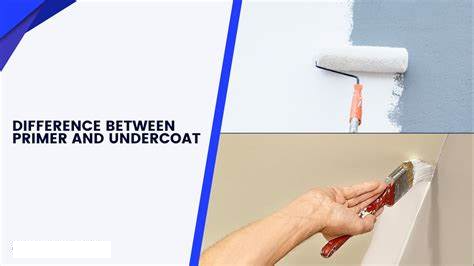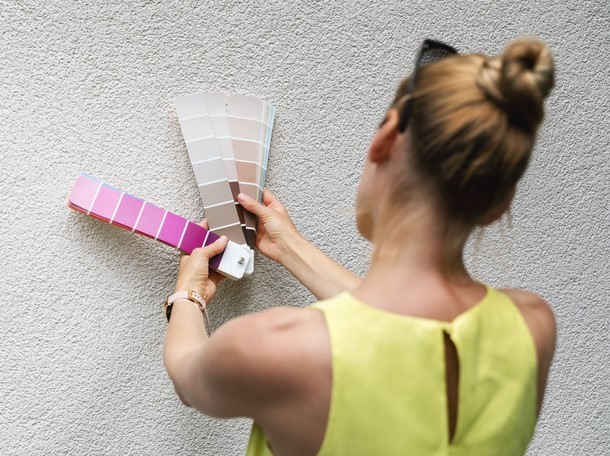PAINT TYPES
BASE COATS
Used on new, uncoated surfaces, primer protects the material beneath and provides a good base for further coats. Most paints can be sprayed with the right sprayer. Oil-based and water-based primers are available. Traditionalists prefer to use oil-based primer before oil-based paints, especially on exterior woodwork. Plaster are usually primed with a coat of latex paint diluted with 10 percent water, known as a “mist coat,” although a stabilizing primer or solution may be needed if the surface is very flaky or powdery. Special primers for other surfaces such as tiles or melamine are also available, and can be over painted with normal paints.
A specially formulated paint used to build up opacity beneath finish coats, one or two coats of first coat paint are usually required before the decorative finish coat is applied. Use pale first coat beneath pale finish coats and a dark first coat beneath dark finish coats. Although most oil-based first coat is suitable for interior or exterior use, exterior first coats are available that will last longer when exposed to the elements. Water-based paints are usually applied in as many coats as are required to provide an even coverage.
FINISH COATS
A latex-based, versatile paint type, flat is normally used for walls and ceilings. Many types of finish are available: dead-flat matt, matt, a water-based eggshell and silk. Some formulations contain vinyl to make them more hardwearing. Flat is also best used on siding materials. It can help the material cope with moisture. Exterior flat is available with a smooth or rough texture. Apply all flat using as many coats as are necessary for even coverage. For use in a sprayer, dilute flat with 10 percent water.
More durable than flat, eggshell has a slight sheen. Always check the exact finish because the degree of sheen varies between manufacturers. It is most commonly used on interior wood surfaces as an alternative to semi-gloss, although some manufacturers will specify that the paint may be used on exterior surfaces. Eggshell can also be used on wall surfaces where a hardwearing finish is required as it is easier to clean. Two coats will usually give an even color; use primer and first coat as required.
A very hardwearing finishing paint, gloss is used mainly on wooden and metal surfaces. Satin is used in the same way as gloss but is slightly less shiny and is increasingly popular, especially for interior woodwork. Both solvent-based and latex-based versions of gloss and satin paints are available. Latex-based paints are easier to apply and less prone to “yellowing” with age, but do not provide as high a shine or hardwearing a finish as solvent-based paints. Almost all gloss and satin paints are suitable for interior or exterior use. Some glosses are formulated especially for exposed exterior surfaces. Gloss is generally applied as a single coat over one or two coats of primer.
WATER-BASED AND SOLVENT-BASED PAINTS
SPECIALTY PAINTS
These flats resist fungal growth and moisture better than standard formulations, although if you have condensation you should consider improving ventilation.
Used on concrete and floorboards, floor paints are typically solvent-based and very hardwearing. Gloss or sheen finishes are available. New concrete floors should be left to cure completely before painting; check their progress with a moisture meter.
High-gloss, smooth and textured (often hammered) metal paints are available. They can be used internally or externally; some types can be applied straight over rust. Thinner is generally required to clean brushes, rather than mineral spirit.
Products such as distemper and limewash, as well as ranges of traditional colors, can now be purchased relatively easily.
PAINTING A ROOM
Prime bare wood with an alkyd paint, then paint it with two or more coats of eggshell, or one or two coats of a suitable shade of first coat and finish with a semi-gloss finish coat
These are usually painted with flat paint. Paint with a latex sealer. Use a mist coat to prime bare masonry walls and ceilings or apply good-quality flat directly onto the surface. Use eggshell for a hardwearing finish
If you want to paint the floor, use specially formulated, hardwearing floor paint
RECOMMENDED APPLICATION METHODS
- Primer: Use a brush, roller or pad.
- First Coat: Use a brush, roller or pad.
- Flat: Use a brush, roller, pad or sprayer.
- Eggshell: Use a brush, roller or pad.
- Gloss: Use a brush.
- Floor Paint (on Wood): Use a brush.
- Floor Paint (on Concrete): Use a brush or roller.
- Metal Paint: Use a brush.








